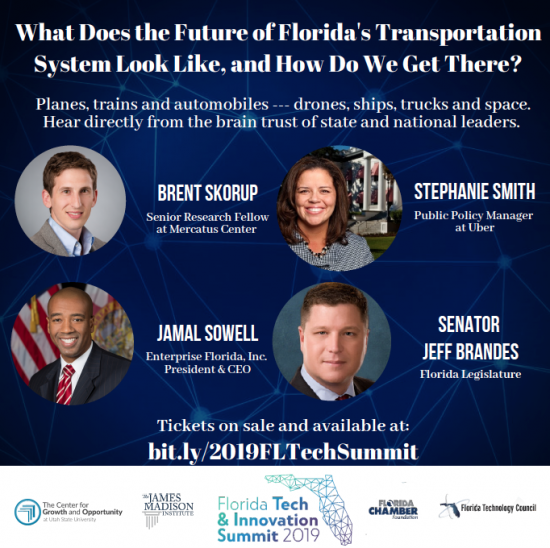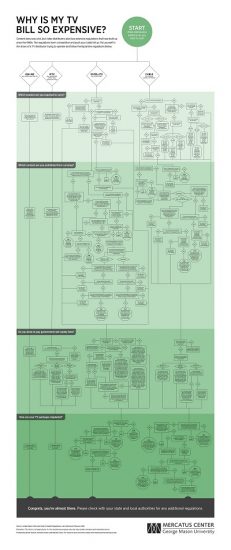Last month I spoke at the Innovation Summit in Orlando, hosted by the James Madison Institute. My co-panelists on the transportation panel were Jamal Sowell, President and CEO of Enterprise Florida, state senator Jeff Brandes, who cosponsored Florida’s autonomous vehicle legislation this year, and Stephanie Smith from Uber. Romina Boccia from the Heritage Foundation was our moderator.

It was a great event and the panel discussion made clear that Florida is at the forefront of autonomous vehicle policy. The panel got me thinking about some nationwide trends that are pushing people towards ride-sharing and, eventually, mobility as a service and autonomous vehicles. Florida seems well positioned but many of these trends will affect the ridesharing and autonomous vehicle market in the next decade.
Rising Cost of Car Ownership
Cars are expensive to own and maintain. Using AAA estimates, the annual cost of a new car in 2019 is $9,300 (nearly $800 per month). These costs are mostly depreciation and insurance, but also include gas, registration, and maintenance.
Used cars are significantly cheaper to own since depreciation is steepest early in a car’s life. I haven’t seen much research on used car costs but out of curiosity I estimated the cost of ownership of our used car. We recently sold my wife’s 2010 Corolla, which she’d bought in 2012. The annual cost of ownership of the Corolla (insurance, maintenance, gas, depreciation) came to about $4,200 ($350 per month).
But costs are much higher for families. Parents adding a teenage boy to their car insurance policy, for instance, can expect their annual insurance costs to jump over $6,000.
Using the AAA numbers and these insurance numbers, we can estimate the costs for adding a new vehicle and a teenage driver for a family budget: from about $15,000 annually (getting a teen driver a new sedan) to about $10,000 annually (getting a teen driver a used compact).
Further, car repair is only going to increase with time. The introduction of sensors and other technology into new cars has caused a spike in repair and insurance costs. Automakers are also adding expensive-to-fix components to engines, like turbochargers and CVTs, in an attempt to comply with federal CAFE standards.
One signal of the increasing costs of repair is rising insurance rates. Over the last four years, the consumer price index for auto insurance increased about 27%, During the same period the CPI for all goods increased about 6%. That increase even exceeds the CPI for hospital services (18%).
This is likely one reason car leasing is becoming more popular, even with good-credit drivers–leasing allows you to shift the (increasing) costs of car depreciation and maintenance to leasing companies.
Mobility as a Service and AVs in Florida
Florida seems to have the perfect recipe for AV and mobility as a service success. First and foremost, they have a governor and state legislature that is welcoming AV companies.
The state also has:
- many students, retirees, tourists, and uninsured drivers who need rides but don’t use a car regularly
- very high insurance premiums
- no-fault auto insurance, which simplifies the claims process in personal injury cases
- flat terrain and no snow
Suppose a couple in Florida is considering getting a third car, a new car for their teenage son. If their son isn’t interested in getting a drivers license (which is increasingly common) and they live in an area with high penetration of ridesharing services, they might be willing to purchase an annual subscription to mobility as a service. For many families on the fence about getting a second or third car, even a $10,000 annual subscription might make financial sense.
AV tech is slowly but surely approaching mass-market deployment. This month, Waymo announced they were increasing the number of autonomous vehicles on Phoenix-area roads without safety drivers in the front seats. These trends in auto leasing and putting off getting a license is accelerating in urbanized areas in the South. It’s probably where mobility as a service companies and, eventually, AV companies will find their largest potential market.

 One of the keys to improving the standard of living for citizens is to make sure it isn’t too difficult for them to form new businesses or find good jobs. Unfortunately, some governments make that process harder than it should be. San Francisco serves as a prime example. An important new report just out from Arizona State University proves that.
One of the keys to improving the standard of living for citizens is to make sure it isn’t too difficult for them to form new businesses or find good jobs. Unfortunately, some governments make that process harder than it should be. San Francisco serves as a prime example. An important new report just out from Arizona State University proves that.
 The Technology Liberation Front is the tech policy blog dedicated to keeping politicians' hands off the 'net and everything else related to technology.
The Technology Liberation Front is the tech policy blog dedicated to keeping politicians' hands off the 'net and everything else related to technology.